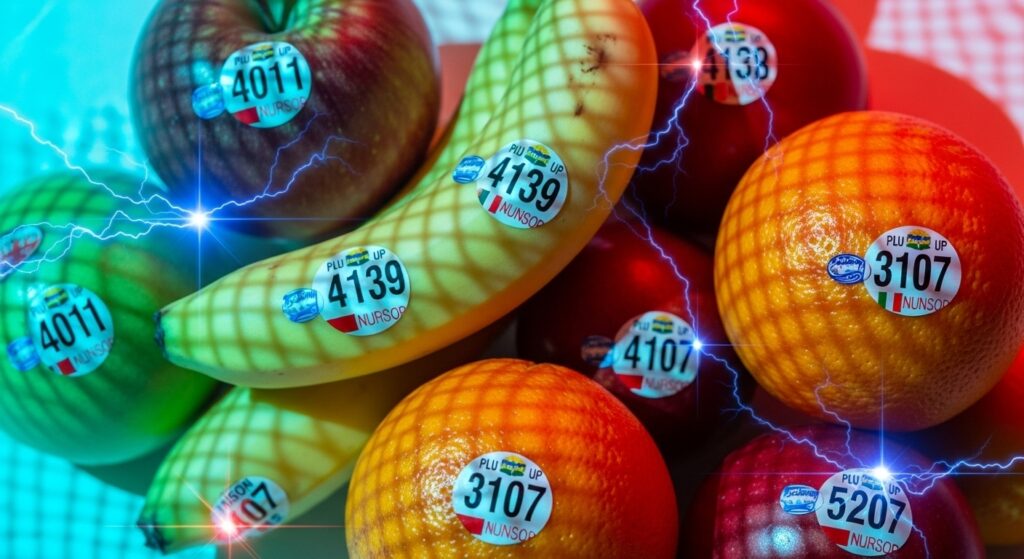What Do the Numbers on Fruit Stickers Mean?
You know those little stickers on apples, bananas, and avocados? If you’ve ever stood in the produce aisle, staring at the codes, wondering about their true plu codes meaning, you’re definitely not alone.
It’s easy to feel confused when two pieces of fruit look the same, but their stickers have different numbers. Here’s the thing: That confusion could mean you accidentally pay more or don’t get the organic produce you want for your kids. I’ve been there myself, trying to shop smart and keep my family healthy.
That’s why learning this Shop Smart method changed everything—it turns sticker confusion into confidence and gives me a super easy way to pick the best fruit every time. Stick with me, and by the end, you’ll be decoding produce like a pro.
Key Takeaways
- Look for any four-digit code to spot regular, conventionally grown produce in the store.
- Find truly organic fruits and veggies by checking for a five-digit code starting with the number “9.”
- Don’t stress about GMOs—a five-digit code starting with “8” is never used on store produce.
- Use these sticker clues each time you shop, and you’ll always get the quality you want.

🛒 What Do Those Fruit Stickers Really Mean?
Let’s start simple: those little stickers with numbers on your fruit? They’re called PLU codes—short for Price Look-Up codes. While the name sounds technical, it’s really just a numbering system used at checkout and behind the scenes to help stores track and identify produce.
These codes are set by the International Federation for Produce Standards (IFPS), and they’re used globally—from local markets to big retail chains. They make it easier for cashiers to ring up fruits and veggies correctly.
What surprised me the most? The real purpose of those stickers isn’t just for customers—it’s mostly for inventory and tracking. Many people assume the codes are secret signs about quality or healthiness, but they’re actually quite practical.
Each PLU code tells you how the fruit was grown:
- 4-digit code (starting with 3 or 4): Conventionally grown
- 5-digit code (starting with 9): Organically grown
- 5-digit code (starting with 8): Genetically modified (rarely used today)
How to Read Fruit Labels: The Simple 3-Part Code System
If you’ve ever wondered how to read fruit labels, it’s easier than it seems. The code always tells you one key thing—how that fruit was grown. Once you figure out this simple 3-part system, you’ll never feel lost at the store again.
The 4-Digit Code: Your Sign for Conventional Produce
First, check if the sticker has a four-digit code. Any fruit with a four-digit number is grown the normal way, which is called “conventional.” This means regular farming: they might use common fertilizers and approved pesticides.
Common examples:
- Bananas with #4011 are conventionally grown—they’re the standard bananas you see everywhere.
- Fuji apples with #4131 are also conventional.
- Avocados with #4046 are the regular, not organic, kind I buy when I want to save a bit of money.
The 5-Digit Code Starting with "9": The Organic Shortcut
Here’s my favorite “ah-ha” tip for organic shoppers: find a five-digit code that starts with a “9.” This is your key to organic.
For example:
- A banana with #94011 means it’s organic, compared to the regular #4011.
- Fuji apples with #94131 are organic, while #4131 are not.
The 5-Digit Code Starting with "8": The GMO Myth
Now, what’s the deal with a five-digit code starting with “8”? Maybe you’ve heard people say it means GMO. The myth about “gmo fruit label numbers” is everywhere online, but here’s the real story: the code “8” was supposed to be for GMO fruit, but stores never actually use it!
Putting It to Practice: What an Apple Fruit Sticker Code Tells You
- One with #4131 is conventionally grown. That’s the standard apple you see most often.
- One with #94131 is organic. That extra “9” at the beginning means better farming practices and no synthetic chemicals.
- The third—well, you won’t see #84131 in any store. The code “8” for GMOs just isn’t in use.
Now, picking the right apple takes me seconds, not minutes. This same trick works for every piece of stickered fruit. So if you’re wondering whether you have a conventional vs organic fruit, just count the digits and check the first number. There’s no more guessing if you’re getting the quality you want.
Mastering Fruit Sticker Codes: Your Final Takeaway
No more standing around, second-guessing in the produce aisle. Now you’ve got the Shop Smart skill of reading PLU codes, and it’s honestly a superpower for picking the right fruit every time. You can trust yourself to get what you pay for and avoid the confusion I once felt.
Now that you can read stickers to guarantee the type of produce you buy, the next Shop Smart step is learning how to tell if it’s perfectly ripe. You can master that in our The Ultimate Guide to Selecting Fresh Produce That Lasts.
Frequently Asked Questions
What does it mean if a PLU code starts with a 3?
A PLU code starting with “3” means the fruit is conventionally grown, just like those with a “4.” Stores use both “3” and “4” for different items—so don’t worry, it isn’t special or rare.
Do produce stickers tell you where the fruit is from?
What if a fruit doesn’t have a sticker?
Does the sticker code tell me if a fruit is ripe?
Ready to Keep More Food Fresh?
- Get our 1-page printable checklist
- Join the “Stay Fresh” email list
- See the full Triple-S Method series
